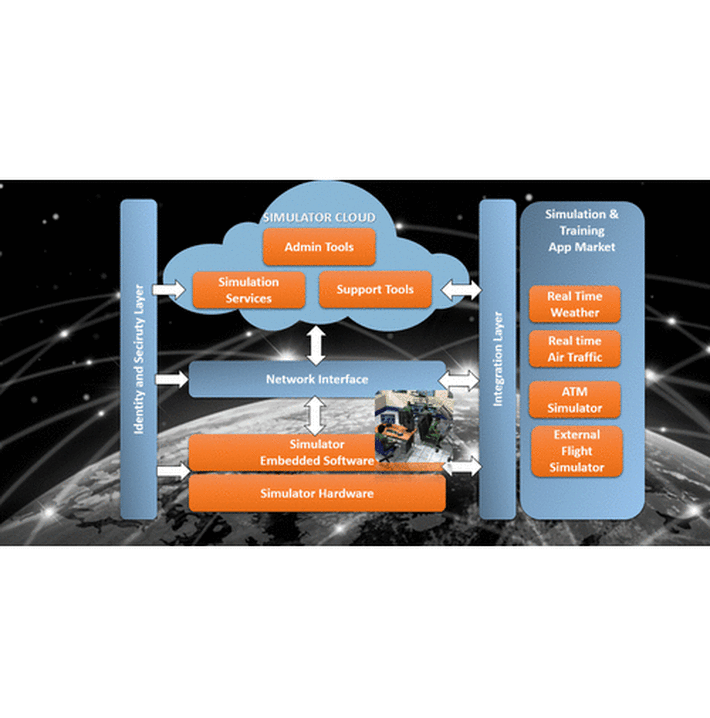
Published on 02/16/2017 | Technology
The market for flight training devices is growing, leveraged by the rising demand for air transportation and the increased request for virtual training in the military air forces. But it could grow at a much bigger pace if platforms were adopted. Training devices are still built as stovepipe and standalone products and therefore they are missing opportunities to deliver more functionality and capabilities if they were able to leverage the network.
Many industrial systems are already migrating to connected products, embracing the Internet of Things or IoT concept. As Michael Porter and James Heppelmann explained in the article "How smart connected products are transforming competition", published on Harvard Business Review on Nov 2014 : "Smart, connected industrial products offer exponencially expanding opportunities for new functionality and capabilities that trascent traditional product boundaries. The changing nature of products is disrupting value chains and forcing companies to rething nearly everything they do ...". Training devices are also industrial products and therefore they will have to evolve to the Internet of Things concept sooner than later. Market will demand not only connected training devices but also the new business models linked to IoT, as product-as-a-service or hybrid models between the extremes of product-as-a-service and conventional ownership, as for example a product sales bundles with a performance based contracts.
"Training devices are also industrial products and therefore they will have to evolve to the Internet of Things concept sooner than later"
The way to achieve this evolution in the flight simulation market is by evolving the current stovepipe training devices to connected products based on simulation platforms that allow to integrate the physical training device, composed by hardware and embedded software with software running on remote servers, owned by the simulator's provider or by external companies in the expanded supply chain that are providing specific software that increase the capabilities and functionalities of the training device.
Platforms would allow to build training devices as the integration of multiple simulation apps. In Simware Solutions, we have named this concept the Internet of Simulations or IoS. In the same way that Internet has transformed how we exchange and share information with others, and the Internet of the Things is promising to transform the way consumer and industrial devices are employed; the Internet of Simulations must unleash the real value of networked or distributed simulation.
In IoS, the stovepipe and standalone training device will evolve to a connected product that it is made up of multiple layers, some of them located in the training center of the customer and others running on remote servers. Conceptual architecture of a Connected Flight training device would be as the one shown in below picture.

"In the same way that Internet has transformed how we exchange and share information with others, and the Internet of the Things is promising to transform the way consumer and industrial devices are employed; the Internet of Simulations must unleash the real value of networked or distributed simulation"
IoS requires a new "technology infrastructure", that allows to provide training services with a hybrid deployment, combining some components on the customer facilities and many others on the cloud. This Cloud based deployment will allow not only a better maintenance and support of the training devices but also the capability to provide the same simulation functionality to different consumers located in different places and using different hardware. For example a simulator & training provider could serve the same high-fidelity simulation capabilities to a full flight simulator located in a dedicated training center in Florida and to a courseware running on a tablet that a pilot is using while is resting in his hotel after a flight in London.
Simware Solutions provides the technology and the architecture to make this evolution without any technical risk. Our Simware platform, as any IoT’s network infrastructure platform, provides the mechanisms to connect the simulators to the network and to share data between the publishers and subscribers or consumers of the data. Simulators can leverage Simware platform to evolve to smart devices that can connect to others in the network through the platform to improve their capabilities.
Simware's bedrock is its Layered Simulation Architecture or LSA. Below figure shows the layered architecture in Simware. These layers can be combined in many different ways to build almost any kind of simulation application, from simple training applications running on web or mobile platforms to complex full flight simulators. LSA is a network-oriented architecture, allowing to deploy a simulation "technology stack" as the one shown in above picture. Simware leverages one of the main data-exchange technologies in IoT, DDS to deliver real time and deterministic performance to the training device, even in a network deployment. Simware adds also compliance with HLA standard to connect with any simulation product already compliant with this distributed simulation technology.
The Internet of Simulations can bring many exciting opportunities to the flight simulation market. The technology to evolve the flight training devices to connected simulators is already in the market and Simware platform is an example. IoS will make easier the access to the flight simulation products to any type of customer, offering him new ways to experience the training. IoS will facilitate also the collaboration between the different stakeholders in the supply chain: the aircraft manufacturer, the simulation & training provider and also to many small and medium companies and research organizations that could provide its products and services embedded in the solutions of the large S&T providers. IoS would allow also to expand the applicability of flight simulations beyond training, for example to be used as test-sites for new equipment acting in this case as virtual prototyping laboratories, connected to the engineering departments of the aircraft or OEM manufacturers.
This article was originally posted on Simware's blog.